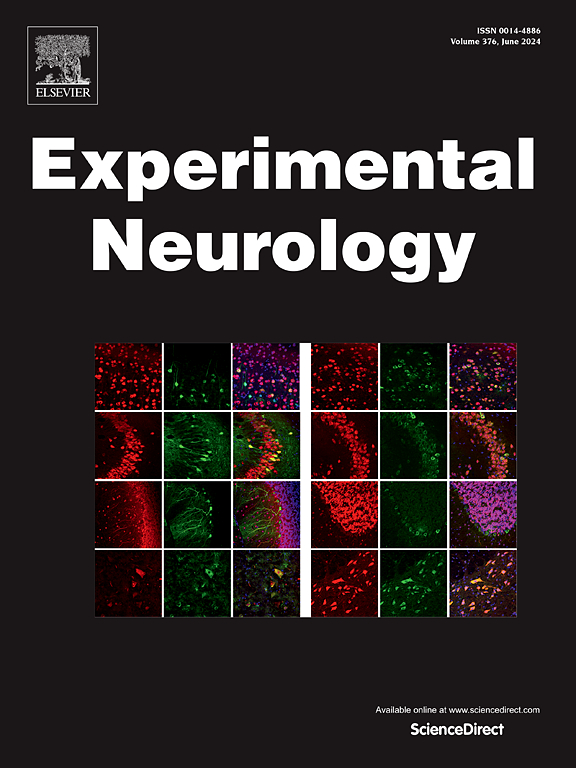Therapeutic effects of intracerebral transplantation of human modified bone marrow-derived stromal cells (SB623) with voluntary and forced exercise in a rat model of ischemic stroke
IF 4.6
2区 医学
Q1 NEUROSCIENCES
引用次数: 0
Abstract
Ischemic stroke results in significant long-term disability and mortality worldwide. Although existing therapies, such as recombinant tissue plasminogen activator and mechanical thrombectomy, have shown promise, their application is limited by stringent conditions. Mesenchymal stem cell (MSC) transplantation, especially using SB623 cells (modified human bone marrow-derived MSCs), has emerged as a promising alternative, promoting neurogenesis and recovery. This study evaluated the effects of voluntary and forced exercise, alone and in combination with SB623 cell transplantation, on neurological and psychological outcomes in a rat model of ischemic stroke. Male Wistar rats that had undergone middle cerebral artery occlusion (MCAO) were divided into six groups: control, voluntary exercise (V-Ex), forced exercise (F-Ex), SB623 transplantation, SB623 + V-Ex, and SB623 + F-Ex. Voluntary exercise was facilitated using running wheels, while forced exercise was conducted on treadmills. Neurological recovery was assessed using the modified neurological severity score (mNSS). Psychological symptoms were evaluated through the open field test (OFT) and forced swim test (FST), and neurogenesis was assessed via BrdU labeling. Both exercise groups exhibited significant changes in body weight post-MCAO. Both exercises enhanced the treatment effect of SB623 transplantation. The forced exercise showed a stronger treatment effect on ischemic stroke than voluntary exercise alone, and the sole voluntary exercise improved depression-like behavior. The SB623 + F-Ex group demonstrated the greatest improvements in motor function, infarct area reduction, and neurogenesis. The SB623 + V-Ex group was most effective in alleviating depression-like behavior. Future research should optimize these exercise protocols and elucidate the underlying mechanisms to develop tailored rehabilitation strategies for stroke patients.

人改良骨髓基质细胞(SB623)脑内移植与自愿和强迫运动对缺血性脑卒中大鼠模型的治疗作用
缺血性中风在全球范围内造成严重的长期残疾和死亡。虽然重组组织纤溶酶原激活剂和机械血栓切除术等现有疗法已显示出前景,但其应用受到严格条件的限制。间充质干细胞(MSC)移植,特别是使用 SB623 细胞(改良的人类骨髓间充质干细胞),已成为一种有希望的替代方法,可促进神经发生和恢复。本研究评估了在缺血性中风大鼠模型中,单独或结合 SB623 细胞移植进行自愿和强迫运动对神经和心理结果的影响。接受大脑中动脉闭塞(MCAO)的雄性 Wistar 大鼠被分为六组:对照组、自主运动组(V-Ex)、强迫运动组(F-Ex)、SB623 移植组、SB623 + V-Ex 组和 SB623 + F-Ex 组。自愿运动使用跑步轮,而强迫运动则在跑步机上进行。使用改良神经系统严重程度评分(mNSS)评估神经系统恢复情况。心理症状通过开阔地测试(OFT)和强迫游泳测试(FST)进行评估,神经发生则通过 BrdU 标记进行评估。两种运动组在MCAO后体重都有明显变化。两种运动都增强了SB623移植的治疗效果。强迫运动对缺血性脑卒中的治疗效果强于单纯的自主运动,而单纯的自主运动能改善抑郁样行为。SB623 + F-Ex 组在运动功能、梗死面积缩小和神经发生方面的改善最大。SB623 + V-Ex 组在减轻抑郁样行为方面最为有效。未来的研究应优化这些运动方案并阐明其潜在机制,从而为中风患者制定量身定制的康复策略。
本文章由计算机程序翻译,如有差异,请以英文原文为准。
求助全文
约1分钟内获得全文
求助全文
来源期刊

Experimental Neurology
医学-神经科学
CiteScore
10.10
自引率
3.80%
发文量
258
审稿时长
42 days
期刊介绍:
Experimental Neurology, a Journal of Neuroscience Research, publishes original research in neuroscience with a particular emphasis on novel findings in neural development, regeneration, plasticity and transplantation. The journal has focused on research concerning basic mechanisms underlying neurological disorders.
 求助内容:
求助内容: 应助结果提醒方式:
应助结果提醒方式:


